Chapter 7 Creating Tables and Views 7 1

Chapter 7: Creating Tables and Views 7. 1 Creating Views with the SQL Procedure 7. 2 Creating Tables with the SQL Procedure (Self-Study) 7. 3 Integrity Constraints (Self-Study) 1

Chapter 7: Creating Tables and Views 7. 1 Creating Views with the SQL Procedure 7. 2 Creating Tables with the SQL Procedure (Self-Study) 7. 3 Integrity Constraints (Self-Study) 2

Objectives n n n 3 Create SQL views. Use SQL views in SQL queries. Use SQL views in other SAS processes.

PROC SQL Views Sometimes referred to as virtual tables, views store query code that retrieves data stored elsewhere. When the query is referenced, the stored query acts as your view to the ever-changing data. 4

What Is a PROC SQL View? A PROC SQL view n is a stored query n contains no actual data n can be derived from one or more tables, PROC SQL views, DATA step views, or SAS/ACCESS views n extracts underlying data each time that it is used, and accesses the most current data n can be referenced in SAS programs in the same way as a data table n cannot have the same name as a data table stored in the same SAS library. 5

Creating a View General form of the CREATE VIEW statement: CREATE VIEW view-name AS query-expression; ! 6 The CREATE VIEW statement differs from the CREATE TABLE statement in that a view is always created from the results of a query. Methods that create empty tables without extracting data are not appropriate for creating views.

Business Scenario Tom Zhou is a sales manager who frequently needs access to personnel information for his direct reports, including name, job title, salary, and years of service. He asked for access to personnel data so that he can generate reports. 7

Business Scenario Considerations: The data Tom needs can be obtained from these tables: orion. Employee_Addresses orion. Employee_Payroll orion. Employee_Organization Tom knows enough SAS to write simple PROC SQL queries and use basic SAS procedures, but cannot write complex joins. Tom should not be allowed access to personnel data for any employee that is not his direct report. 8

Creating a View A view containing personnel information for Tom Zhou’s direct reports can provide the information that Tom needs and avoid inadvertent access to data for employees who do not report to him. proc sql; create view orion. Tom_Zhou as select Employee_Name as Name format=$25. 0, Job_Title as Title format=$15. 0, Salary 'Annual Salary' format=comma 10. 2, int((today()-Employee_Hire_Date)/365. 25) as YOS 'Years of Service' from orion. Employee_Addresses as a, orion. Employee_Payroll as p, orion. Employee_Organization as o where a. Employee_ID=p. Employee_ID and o. Employee_ID=p. Employee_ID and Manager_ID=120102; 9 s 107 d 10

Using a View Tom can use the view to produce simple reports. proc sql; title "Tom Zhou's Direct Reports"; title 2 "By Title and Years of Service"; select * from orion. Tom_Zhou order by Title desc, YOS desc; Partial PROC SQL Output (executed 02 FEB 2008) Tom Zhou's Direct Reports By Title and Years of Service Annual Years of Name Title Salary Service ƒƒƒƒƒƒƒƒƒƒƒƒƒƒƒƒƒƒƒƒƒƒƒƒƒƒƒƒƒƒƒƒ Nowd, Fadi Sales Rep. IV 30, 660. 00 34 Hofmeister, Fong Sales Rep. IV 32, 040. 00 28 Phoumirath, Lynelle Sales Rep. IV 30, 765. 00 21 Platts, Alexei Sales Rep. IV 32, 490. 00 10 10 s 107 d 10

Using a View Tom can also use the view to produce simple descriptive statistics to help him better manage his group. title "Tom Zhou's Group - Salary Statistics"; proc means data=orion. Tom_Zhou min mean max; var salary; class title; run; Partial PROC MEANS Output Tom Zhou's Group - Salary Statistics The MEANS Procedure Analysis Variable : Salary Annual Salary 11 Title N Obs Minimum Mean Maximum ƒƒƒƒƒƒƒƒƒƒƒƒƒƒƒƒƒƒƒƒƒƒƒƒƒƒ Sales Rep. I 18 25185. 00 26466. 67 27260. 00 Sales Rep. II 13 26165. 00 27123. 46 28100. 00 Sales Rep. III 12 28135. 00 29895. 42 36605. 00 Sales Rep. IV 5 30660. 00 31369. 00 32490. 00 ƒƒƒƒƒƒƒƒƒƒƒƒƒƒƒƒƒƒƒƒƒƒƒƒƒƒ s 107 d 10

Administering Views After a view is created, you can use the DESCRIBE VIEW statement to investigate the view’s contents. proc sql; describe view orion. Tom_Zhou; Partial SAS Log NOTE: SQL view ORION. TOM_ZHOU is defined as: select Employee_Name as Name format=$25. 0, Job_Title as Title format=$15. 0, Salary label='Annual Salary' format=COMMA 10. 2, INT((TODAY()-Employee_Hire_Date)/365. 25) as YOS label='Years of Service' from ORION. EMPLOYEE_ADDRESSES a, ORION. EMPLOYEE_PAYROLL p, ORION. EMPLOYEE_ORGANIZATION o where (a. Employee_ID=p. Employee_ID) and (o. Employee_ID=p. Employee_ID) and (Manager_ID=120102); 12 s 107 d 10

13

7. 01 Quiz What differences are there between the SQL code written to the SAS log by the DESCRIBE VIEW statement and the CREATE VIEW code, which actually created the view orion. Tom_Zhou? 14

7. 01 Quiz – Correct Answer DESCRIBE VIEW Original Differences between the SQL code produced by the DESCRIBE VIEW statement and the actual CREATE VIEW code, which created orion. Tom_Zhou: 15 select Employee_Name as Name format=$25. 0, Job_Title as Title format=$15. 0, Salary 'Annual Salary' format=comma 10. 2, int((today()-Employee_Hire_Date)/365. 25) as YOS 'Years of Service' from ORION. Employee_Addresses as a, ORION. Employee_Payroll as p, ORION. Employee_Organization as o where a. Employee_ID=p. Employee_ID and o. Employee_ID=p. Employee_ID and Manager_ID=120102; select Employee_Name as Name format=$25. 0, Job_Title as Title format=$15. 0, Salary label='Annual Salary' format=COMMA 10. 2, int((today()-Employee_Hire_Date)/365. 25) as YOS label='Years of Service' from ORION. EMPLOYEE_ADDRESSES a, ORION. EMPLOYEE_PAYROLL p, ORION. EMPLOYEE_ORGANIZATION o where (a. Employee_ID=p. Employee_ID) and (o. Employee_ID=p. Employee_ID) and (Manager_ID=120102);

7. 01 Quiz – Correct Answer DESCRIBE VIEW Original Differences between the SQL code produced by the DESCRIBE VIEW statement and the actual CREATE VIEW code, which created orion. Tom_Zhou: 16 select Employee_Name as Name format=$25. 0, Job_Title as Title format=$15. 0, 1. You used ANSI labels in Salary 'Annual Salary' format=comma 10. 2, the CREATE VIEW code. int((today()-Employee_Hire_Date)/365. 25) as YOS 'Years of Service' DESCRIBE VIEW from ORION. Employee_Addresses as a, ORION. Employee_Payroll as produced SAS (LABEL=) p, ORION. Employee_Organization as o syntax. where a. Employee_ID=p. Employee_ID and o. Employee_ID=p. Employee_ID and Manager_ID=120102; select Employee_Name as Name format=$25. 0, Job_Title as Title format=$15. 0, Salary label='Annual Salary' format=COMMA 10. 2, int((today()-Employee_Hire_Date)/365. 25) as YOS label='Years of Service' from ORION. EMPLOYEE_ADDRESSES a, ORION. EMPLOYEE_PAYROLL p, ORION. EMPLOYEE_ORGANIZATION o where (a. Employee_ID=p. Employee_ID) and (o. Employee_ID=p. Employee_ID) and (Manager_ID=120102);

7. 01 Quiz – Correct Answer DESCRIBE VIEW Original Differences between the SQL code produced by the DESCRIBE VIEW statement and the actual CREATE VIEW code, which created orion. Tom_Zhou: 17 select Employee_Name as Name format=$25. 0, Job_Title as Title format=$15. 0, Salary 'Annual Salary' format=comma 10. 2, int((today()-Employee_Hire_Date)/365. 25) as YOS 'Years of Service' from ORION. Employee_Addresses as a, ORION. Employee_Payroll as p, ORION. Employee_Organization as o where a. Employee_ID=p. Employee_ID and o. Employee_ID=p. Employee_ID and 2. You used the keyword AS to assign table aliases. Manager_ID=120102; DESCRIBEas. VIEW the keyword AS when select Employee_Name omitted format=$25. 0, Job_Title as Title format=$15. 0, assigning table aliases. Salary label='Annual Salary' format=COMMA 10. 2, int((today()-Employee_Hire_Date)/365. 25) as YOS label='Years of Service' from ORION. EMPLOYEE_ADDRESSES a, ORION. EMPLOYEE_PAYROLL p, ORION. EMPLOYEE_ORGANIZATION o where (a. Employee_ID=p. Employee_ID) and (o. Employee_ID=p. Employee_ID) and (Manager_ID=120102);

7. 01 Quiz – Correct Answer DESCRIBE VIEW Original Differences between the SQL code produced by the DESCRIBE VIEW statement and the actual CREATE VIEW code, which created orion. Tom_Zhou: 18 select Employee_Name as Name format=$25. 0, Job_Title as Title format=$15. 0, Salary 'Annual Salary' format=comma 10. 2, int((today()-Employee_Hire_Date)/365. 25) as YOS 'Years of Service' from ORION. Employee_Addresses as a, ORION. Employee_Payroll as p, ORION. Employee_Organization as o where a. Employee_ID=p. Employee_ID and o. Employee_ID=p. Employee_ID and Manager_ID=120102; select Employee_Name as Name format=$25. 0, Job_Title as Title format=$15. 0, 3. DESCRIBE VIEW Salary' insertedformat=COMMA 10. 2, parentheses around Salary label='Annual int((today()-Employee_Hire_Date)/365. 25) the expressions between each AND operator. as YOS label='Years of Service' from ORION. EMPLOYEE_ADDRESSES a, ORION. EMPLOYEE_PAYROLL p, ORION. EMPLOYEE_ORGANIZATION o where (a. Employee_ID=p. Employee_ID) and (o. Employee_ID=p. Employee_ID) and (Manager_ID=120102);

19

7. 02 Poll Considering the differences discussed previously, if you submit the code produced by the DESCRIBE VIEW statement, would the view produced be identical to the original view? Yes No 20

7. 02 Poll – Correct Answer Considering the differences discussed previously, if you submit the code produced by the DESCRIBE VIEW statement, would the view produced be identical to the original view? Yes No 21

Views: Advantages You can use views to do the following: n avoid storing copies of large data tables n avoid a frequent refresh of data table copies. When the underlying data changes, a view surfaces the most current data n pull together data from multiple database tables and multiple libraries or databases n simplify complex queries n prevent other users from inadvertently altering the query code 22

Views: Disadvantages n n n 23 Because views access the most current data in changing tables, the results might be different each time that you access the view. Views can require significant resources each time that they execute. With a view, you save disk storage space at the cost of extra CPU and memory usage. When accessing the same data several times in a program, use a table instead of a view. This ensures consistent results from one step to the next and can significantly reduce the resources that are required.

Business Scenario You created an SQL view to provide Tom Zhou, a sales manager, access to personnel data for his direct reports. Tom was pleased and used his new view daily. Later, to simplify reporting, Tom copied his view to the folder on his hard drive where he stores all of his personal, permanent SAS files. Now Tom reports that the view does not work anymore, and he asked for your help to resolve the problem. 24

Two-Level Table Names in Permanent Views The following program creates a permanent view, Level_II, in the default SAS library location, using the libref test instead of orion: libname test '. '; proc sql; create view test. Level_II as select Employee_ID, Gender, Job_Title as Title from test. Staff where scan(Job_Title, -1) ='II' and Emp_Term_Date is missing ; 25 s 107 d 11

Two-Level Table Names in Permanent Views Step 1: Assign a libref. libname test '. '; s: workshop libname=test Staff 26 s 107 d 11 . . .

Two-Level Table Names in Permanent Views Step 1: Assign a libref. Step 2: Create the view. s: workshop libname=test proc sql; create view test. Level_II as select Employee_ID, Employee_Gender, Job_Title from test. Staff where … ; Staff Level_II Stored Query select Employee_ID, Employee_Gender, Job_Title from test. Staff where … ; 27 s 107 d 11 . . .

Two-Level Table Names in Permanent Views Step 1: Assign a libref. Step 2: Create the view. Step 3: Access the view. proc sql; select * from test. Level_II; The stored query executes. 28 s: workshop libname=test Staff Level_II select Employee_ID, Employee_Gender, Job_Title from test. Staff where … ; s 107 d 11 . . .

Two-Level Table Names in Permanent Views Step 1: Assign a libref. Step 2: Create the view. Step 3: Access the view. proc sql; select * from test. Level_II; s: workshop libname=test Staff Level_II Partial SQL Output Employee Job ID Gender Title ƒƒƒƒƒƒƒƒƒƒƒƒƒƒƒƒƒ 120121 F Sales Rep. II 120122 F Sales Rep. II 120126 M Sales Rep. II 120127 F Sales Rep. II 29 s 107 d 11

Two-Level Table Names in Permanent Views Several weeks later, you remember creating the Level_II view and decide that it is the perfect source to use for the current reporting project. 30

Two-Level Table Names in Permanent Views Step 1: Assign a libref. libname orion '. '; s: workshop libname=orion Staff Level_II 31 s 107 d 12 . . .

Two-Level Table Names in Permanent Views Step 1: Assign a libref. Step 2: Access the view. proc sql; select * from orion. Level_II; 32 s: workshop libname=orion Staff Level_II s 107 d 12 . . .

Two-Level Table Names in Permanent Views Step 1: Assign a libref. Step 2: Access the view. proc sql; select * from orion. Level_II; The stored query executes. 33 s: workshop libname=orion Staff Level_II select Employee_ID, Employee_Gender, Job_Title from test. Staff where … ; s 107 d 12 . . .

Two-Level Table Names in Permanent Views Step 1: Assign a libref. s: workshop libname=orion Step 2: Access the view. Staff proc sql; select * from orion. Level_II; Level_II The stored query executes. select Employee_ID, Employee_Gender, Job_Title from test. Staff where … ; There is no test libref assigned. 34 s 107 d 12

35

7. 03 Multiple Choice Poll What will be the result of executing the code on the previous slide? a. b. c. 36 The code executes properly and a report is produced. The SAS log contains only the expected messages. The code executes properly and a report is produced. A special note is written to the SAS log about the VIEW libref. The code does not execute and no report is produced. An error message is written to the SAS log.

7. 03 Multiple Choice Poll – Correct Answer What will be the result of executing the code on the previous slide? The code executes properly and a report is produced. The SAS log contains only the expected messages. b. The code executes properly and a report is produced. A special note is written to the SAS log about the VIEW libref. c. The code does not execute and no report is Partial produced. SAS Log: ERROR: An File TEST. STAFF. DATA not exist. error message isdoes written to the SAS log. a. NOTE: The SAS System stopped processing this step because of errors. 37

Two-Level Table Names in Permanent Views You can use two techniques to address the issues demonstrated when you reference permanent tables in views: n ANSI method: Omit the libref; use a single-level table name. n SAS enhancement: Embed the LIBNAME statement with a USING clause. 38

Two-Level Table Names in Permanent Views ANSI Example: Omit the libref. libname test '. '; proc sql; create view test. Level_II as select Employee_ID, Gender, Job_Title as Title from Staff where scan(Job_Title, -1) ='II' and Emp_Term_Date is missing; This method works as long as the view and table are stored in the same location. When a view is not stored in the same location as its source tables (co-located), this method is not appropriate. 39 . . .

Two-Level Table Names in Permanent Views ANSI Example: Omit the libref. libname test '. '; proc sql; create view test. Level_II as select Employee_ID, Gender, Job_Title as Title from Staff where scan(Job_Title, -1) ='II' and Emp_Term_Date is missing; A SAS programmer might interpret this as a reference to the table work. Staff. 40 . . .

Two-Level Table Names in Permanent Views ANSI Example: Omit the libref. libname test '. '; proc sql; create view test. Level_II as select Employee_ID, Gender, Job_Title as Title from Staff where scan(Job_Title, -1) ='II' and Emp_Term_Date is missing; At view execution, PROC SQL interprets this as the following: "Look in the location where the Level_II view is stored for a table named Staff. " 41

Two-Level Table Names in Permanent Views Step 1: Assign a libref. libname test '. '; s: workshop libname=test Staff 42 s 107 d 13 a . . .

Two-Level Table Names in Permanent Views Step 1: Assign a libref. s: workshop libname=test Step 2: Create the view. proc sql; create view test. Level_II as select Employee_ID, Employee_Gender, Job_Title from Staff where … ; Staff Level_II select Employee_ID, Employee_Gender, Job_Title from Staff where … ; 43 s 107 d 13 a . . .

Two-Level Table Names in Permanent Views Step 1: Assign a libref. Step 2: Create the view. Step 3: Access the view. s: workshop libname=test Staff Level_II proc sql; select * from test. Level_II; The stored query executes. 44 select Employee_ID, Employee_Gender, Job_Title from Staff where … ; s 107 d 13 a . . .

Two-Level Table Names in Permanent Views Step 1: Assign a libref. Step 2: Create the view. Step 3: Access the view. s: workshop libname=test Staff Level_II proc sql; select * from test. Level_II; Look in the co-located table named Staff. 45 select Employee_ID, Employee_Gender, Job_Title from Staff where … ; s 107 d 13 a

46

7. 04 Multiple Choice Poll What will be the result of executing the code on the previous slide? a. b. c. 47 The code executes properly and a report is produced. The SAS log contains only the expected messages. The code executes properly and a report is produced. A special note is written to the SAS log about the VIEW libref. The code does not execute and no report is produced. An error message is written to the SAS log.

7. 04 Multiple Choice Poll – Correct Answer What will be the result of executing the code on the previous slide? a. b. c. 48 The code executes properly and a report is produced. The SAS log contains only the expected messages. The code executes properly and a report is produced. A special note is written to the SAS log about the VIEW libref. The code does not execute and no report is produced. An error message is written to the SAS log.

Two-Level Table Names in Permanent Views Step 1: Assign a libref. Step 2: Create the view. Step 3: Access the view. s: workshop libname=test Staff Level_II proc sql; select * from test. Level_II; Partial SQL Output Employee Job ID Gender Title ƒƒƒƒƒƒƒƒƒƒƒƒƒƒƒƒƒ 120121 F Sales Rep. II 120122 F Sales Rep. II 120126 M Sales Rep. II 120127 F Sales Rep. II 49 s 107 d 13 a

Two-Level Table Names in Permanent Views You move the Level_II view file to your personal storage area, for example, . /test. Then you attempt to use the view to create a report. 50

Two-Level Table Names in Permanent Views Step 1: Assign the librefs. libname orion '. '; libname test '. /test'; s: workshop libname=orion Staff s: workshoptest libname=test Level_II 51 s 107 d 13 a. . .

Two-Level Table Names in Permanent Views Step 1: Assign the librefs. Step 2: Access the view. proc sql; select * from test. Level_II; s: workshop libname=orion Staff s: workshoptest libname=test Level_II 52 s 107 d 13 a. . .

Two-Level Table Names in Permanent Views Step 1: Assign the librefs. Step 2: Access the view. proc sql; select * from test. Level_II; s: workshop libname=orion Staff s: workshoptest libname=test Level_II The stored query executes. 53 select Employee_ID, Employee_Gender, Job_Title from Staff where … ; s 107 d 13 a. . .

Two-Level Table Names in Permanent Views s: workshop Step 1: Assign the librefs. libname=orion Step 2: Access the view. Staff proc sql; select * from test. Level_II; s: workshoptest libname=test Level_II select Employee_ID, Employee_Gender, Job_Title from Staff where … ; There is no co-located table named 54 Staff! s 107 d 13 a

55

7. 05 Multiple Choice Poll What will be the result of executing the code on the previous slide? a. b. c. 56 The code executes properly and a report is produced. The SAS log contains only the expected messages. The code executes properly and a report is produced. A special note is written to the SAS log about the VIEW libref. The code does not execute and no report is produced. An error message is written to the SAS log.

7. 05 Multiple Choice Poll – Correct Answer What will be the result of executing the code on the previous slide? The code executes properly and a report is produced. The SAS log contains only the expected messages. b. The code executes properly and a report is produced. A special note is written to the SAS log about the VIEW libref. c. The code does not execute and no report is Partial SAS Log produced. ERROR: Libname TEST is not assigned. An error message is written to the SAS log. NOTE: The SAS System stopped processing this step because of errors. a. 57

Two-Level Table Names in Permanent Views SAS Enhancement: Embed the LIBNAME statement with a USING clause. CREATE VIEW proc-sql-view AS query-expression <USING LIBNAME-clause<, …LIBNAME-clause>>; The scope of the embedded libref is local to the view, and it will not conflict with an identically named libref in the SAS session. 58

Two-Level Table Names in Permanent Views Example: Embed the LIBNAME statement with a USING clause. libname test '. /test'; proc sql; create view test. Level_II as select Employee_ID, Gender, Job_Title as Title from orion. Staff where scan(Job_Title, -1) ='II' and Emp_Term_Date is missing using libname orion 's: workshop'; When the view test. Level_II executes, the libref orion always refers to the location 's: workshop'. The path defined in an embedded LIBNAME statement might not be valid if the view is executed on a different operating system. 59

Two-Level Table Names in Permanent Views Step 1: Assign some librefs. libname orion 'c: temp'; libname sasdata '. '; libname test '. /test'; c: temp libname=orion Other. Stuff s: workshop libname=orion Staff s: workshoptest libname=test Level_II 60 s 107 d 13 b . . .

Two-Level Table Names in Permanent Views Step 1: Assign some librefs. Step 2: Access the view. proc sql; select * from test. Level_II; c: temp libname=orion Other. Stuff s: workshop libname=orion Staff s: workshoptest libname=test Level_II 61 s 107 d 13 b . . .

Two-Level Table Names in Permanent Views Step 1: Assign some librefs. Step 2: Access the view. proc sql; select * from test. Level_II; c: temp libname=orion Other. Stuff s: workshop libname=orion Staff s: workshoptest libname=test Level_II The stored query executes. 62 select Employee_ID, Employee_Gender, Job_Title from orion. Staff where … using libname orion 's: workshop'; s 107 d 13 b . . .

Two-Level Table Names in Permanent Views Step 1: Assign some librefs. Step 2: Access the view. Look in s: workshop for the Staff table. c: temp libname=orion Other. Stuff Ignore this s: workshop libname=orion Staff s: workshoptest libname=test Level_II select Employee_ID, Employee_Gender, Job_Title from orion. Staff where … using libname orion 's: workshop'; 63 s 107 d 13 b . . .

Two-Level Table Names in Permanent Views Step 1: Assign some librefs. Step 2: Access the view. c: temp libname=orion Other. Stuff s: workshop libname=orion Staff Partial SQL Output Employee Job ID Gender Title ƒƒƒƒƒƒƒƒƒƒƒƒƒƒƒƒƒ 120121 F Sales Rep. II 120122 F Sales Rep. II 120126 M Sales Rep. II 120127 F Sales Rep. II 64 s: workshoptest libname=test Level_II s 107 d 13 b

Business Scenario Re-create the view for Tom Zhou. Use an embedded LIBNAME statement to make it portable. Tom can then copy the view to any location that he chooses and use it to create his reports. 65

Making a View Portable proc sql; create view orion. Tom_Zhou as select Employee_Name as Name format=$25. 0, Job_Title as Title format=$15. 0, Salary "Annual Salary" format=comma 10. 2, int((today()-Employee_Hire_Date)/365. 25) as YOS 'Years of Service' from orion. Employee_Addresses as a, orion. Employee_Payroll as p, orion. Employee_Organization as o where a. Employee_ID=p. Employee_ID and o. Employee_ID=p. Employee_ID and Manager_ID=120102 using libname orion 's: workshop' ; quit; 66 s 107 d 14

Making a View Portable Tom copied the new view to his hard drive and is happily using it to generate reports. libname tom ". /Test"; proc copy in=orion out=tom memtype=view; select Tom_Zhou; run; title "Tom Zhou's Group - Salary Statistics"; proc means data=tom. Tom_Zhou min mean max; var salary; class Level; run; title; 67 s 107 d 14

Using Views to Enhance Security PROC MEANS Output Tom Zhou's Group - Salary Statistics The MEANS Procedure Analysis Variable : Salary Annual Salary Title N Obs Minimum Mean Maximum ƒƒƒƒƒƒƒƒƒƒƒƒƒƒƒƒƒƒƒƒƒƒƒƒƒƒ Sales Rep. I 18 25185. 00 26466. 67 27260. 00 Sales Rep. II 13 26165. 00 27123. 46 28100. 00 Sales Rep. III 12 28135. 00 29895. 42 36605. 00 Sales Rep. IV 5 30660. 00 31369. 00 32490. 00 ƒƒƒƒƒƒƒƒƒƒƒƒƒƒƒƒƒƒƒƒƒƒƒƒƒƒ 68 s 107 d 14

General Guidelines for Using Views n n 69 Avoid ORDER BY clauses in view definitions, which force data sorting each time that the view is referenced. When you create a permanent view with permanent tables in the FROM clause, use a USING clause to specify the location of the libraries to make your view portable.

70

Exercise This exercise reinforces the concepts discussed previously. 71

Chapter 7: Creating Tables and Views 7. 1 Creating Views with the SQL Procedure 7. 2 Creating Tables with the SQL Procedure (Self-Study) 7. 3 Integrity Constraints (Self-Study) 72

Objectives n n 73 Create a new table by defining the column structure. Create a new table by copying column structure from an existing table. Load data into a table. Create a new table and add data using a single query.

Creating Tables with SQL Multiple techniques are used to create tables and insert data into tables with SQL. Method 74 Syntax Result 1 CREATE TABLE table-name Create an empty (column-name type(length) table by manually <, . . . column-name type(length)>); specifying all column attributes. 2 CREATE TABLE table-name LIKE old-table-name; 3 CREATE TABLE table-name AS Create a table and query-expression; add data all in one step, using a query. Create an empty table by copying column attributes from an existing table using a LIKE clause.

Creating Tables Method 1: Define the columns. General form of the CREATE TABLE statement: CREATE TABLE table-name (column-name type(length) <, . . . column-name type(length)> ); 75

Method 1: Defining Columns Method 1: Define the columns. You must add data later. proc sql; Name the create table Discounts (Product_ID num format=z 12. , new table. Start_Date date, End_Date date, Discount num format=percent. ); quit; Define the columns. The table definition is enclosed in parentheses. Individual column definitions are separated by commas. 76 s 107 d 01

Method 1: Defining Columns For ANSI compliance, PROC SQL accepts the following data types in table definitions: ANSI Type 77 Resulting SAS Type Default Length Default Format CHAR(n) Character 8 $w. VARCHAR Character 8 $w. INTEGER Numeric 8 BEST. SMALLINT Numeric 8 BEST. DECIMAL Numeric 8 BEST. NUMERIC Numeric 8 BEST. FLOAT Numeric 8 BEST. REAL Numeric 8 BEST. DOUBLE PRECISION Numeric 8 BEST. DATE 8 DATE. Numeric

Method 1: Defining Columns Example: Create the table structure for the Testing_Types table using ANSI standard terms to define the columns. proc sql; create table Testing_Types (Char_Column char(4), Varchar_Column varchar, Int_Column int, Small. Int_Column smallint, Dec_Column dec, Num_Column num, Float_Column float, Real_Column real, Date_Column date, Double_Column double precision); quit; 78 s 107 d 02

Method 1: Defining Columns Partial SAS Log NOTE: Table WORK. TESTING_TYPES created, with 0 rows and 10 columns. Partial PROC CONTENTS Output # 1 2 3 4 5 6 7 8 9 10 79 Variable Type Len Char_Column Varchar_Column Int_Column Small. Int_Column Dec_Column Num_Column Float_Column Real_Column Date_Column Double_Column Char Num Num 4 8 8 8 8 8 Format Informat DATE.

80

Setup for the Poll Submit the program s 107 d 01 and review the SAS log. proc sql; create table Discounts (Product_ID num format=z 12. , Start_Date date, End_Date date, Discount num format=percent. ); describe table Discounts; quit; 81 s 107 d 01

7. 06 Multiple Choice Poll Based on the query in program s 107 d 01, which different data types does the work. Discounts table have? a. b. c. d. 82 All columns are NUMERIC type. Some columns are DATE type and some are NUMERIC type. Some columns are CHARACTER type, some are DATE type, and some are NUMERIC type.

7. 06 Multiple Choice Poll – Correct Answer Based on the query in program s 107 d 01, which different data types does the work. Discounts table have? a. b. c. d. All columns are NUMERIC type. Some columns are DATE type and some are NUMERIC type. Some columns are CHARACTER type, some are DATE type, and some are NUMERIC type. SAS has only two data types: character and numeric. In PROC SQL, if you specify the ANSI data type DATE when you create a table, the actual data type in the underlying SAS data set is numeric. 83

Creating Tables Method 2: Copy the table structure. General form of the CREATE TABLE statement: CREATE TABLE table-name-2 LIKE table-name-1; 84

Method 2: Copying Table Structure Copy the structure of orion. Sales to create the work. New_Sales_Staff table. proc sql; create table work. New_Sales_Staff like orion. Sales; quit; 85 s 107 d 02 a

Method 2: Copying Table Structure Partial SAS Log NOTE: Table WORK. NEW_SALES_STAFF created, with 0 rows and 9 columns. Partial PROC CONTENTS Output 86 # Variable Type Len 1 2 3 4 5 6 7 8 9 Employee_ID First_Name Last_Name Gender Salary Job_Title Country Birth_Date Hire_Date Num Char Num Char Num 8 12 18 1 8 25 2 8 8 Format 12.

Creating Tables (Review) Method 3: Create and populate a table with an SQL query. General form of the CREATE TABLE statement: CREATE TABLE table-name AS query-expression; 87

Method 3: Create and Populate a Table with an SQL Query (Review) The SELECT list defines the structure of the work. Melbourne table, and the rows are populated with the data returned by the query. Define table columns. proc sql; create table work. Melbourne as select Employee_Name as Name, Salary from orion. Staff as s, orion. Employee_addresses as a where s. Employee_ID=a. Employee_ID and City ="Melbourne"; Filter the data rows added to the table. 88 s 107 d 03

Method 3: Create and Populate a Table with an SQL Query (Review) Partial SAS Log NOTE: Table WORK. MELBOURNE created, with 41 rows and 2 columns. Partial PROC CONTENTS Output. . . # 1 2 89 Data Set Name Variable Name Salary Type Char Num WORK. MELBOURNE Len 40 8 Observations 41 Format Label DOLLAR 12. Employee Annual Salary

Method 3: Create and Populate a Table with an SQL Query (Review) After you create a table, a separate query is required to display the data from the new table. title "Melbourne Employees"; select * from work. Melbourne order by name; title; quit; 90 s 107 d 03

Method 3: Create and Populate a Table with an SQL Query (Review) Partial PROC SQL Output Melbourne Employees Employee Annual Name Salary ƒƒƒƒƒƒƒƒƒƒƒƒƒƒƒƒƒƒƒƒƒƒƒƒƒƒƒ Aisbitt, Sandy $26, 060 Barcoe, Selina $25, 275 Blanton, Brig $26, 910 Catenacci, Reyne $26, 665 Chantharasy, Judy $26, 390 91

Adding Data to a Table The INSERT statement can be used to add data to an empty table, or to append data to a table that already contains data, using one of three methods. Method 92 Syntax Description A INSERT INTO table-name One clause per row SET column-name=value, using column-value column-name=value, . . . ; pairs B INSERT INTO table-name <(column list)> VALUES (value, . . . ); One clause per row using positional values C INSERT INTO table-name <(column list)> SELECT columns FROM table-name; A query returning multiple rows, and based on positional values

Method A: Adding Data with a SET Clause The SET clause requires that you add data using column name–value pairs: insert into Discounts set Product_ID=230100300006, Start_Date='01 MAR 2007'd, End_Date='15 MAR 2007'd, Discount=. 33 set Product_ID=230100600018, Start_Date='16 MAR 2007'd, End_Date='31 MAR 2007'd, Discount=. 15 ; 93 s 107 d 04

Method B: Adding Data with a VALUES Clause The VALUES clause adds data to the columns in a single row of data. insert into Discounts values (230100300006, '01 MAR 2007'd, '15 MAR 2007'd, . 33) values (230100600018, '16 MAR 2007'd, '31 MAR 2007'd, . 15); The VALUES clause must produce values in the same order as the INSERT INTO statement column list. 94 s 107 d 05

Method B: Adding Data with a VALUES Clause Optionally, the INSERT statement can list the columns into which data is to be inserted, in the order in which the VALUES clause will provide the data. insert into Discounts (Start_Date, End_Date, Product_ID, Discount) values ('01 MAR 2007'd, '15 MAR 2007'd, 230100300006, . 33) values ('16 MAR 2007'd, '31 MAR 2007'd, 230100600018, . 15); 95 s 107 d 05

Method B: Adding Data with a VALUES Clause Example: Load the Discounts table created earlier using the INSERT statement. insert into Discounts (Product_ID, Start_Date, End_Date, Discount) values (220200200022, '01 Mar 2007'd, '31 Mar 2007'd, . 35) values (220200200024, '01 Mar 2007'd, '31 Mar 2007'd, . 35) ; 96 s 107 d 06

Method B: Adding Data with a VALUES Clause select * from Discounts; PROC SQL Output Product_ID Start_Date End_Date Discount ƒƒƒƒƒƒƒƒƒƒƒƒƒƒƒƒƒƒƒƒƒƒ 220200200022 01 MAR 07 35% 220200200024 01 MAR 07 35% 97 s 107 d 06

Method C: Adding Data with a Query Rows returned by the query are appended to the table. proc sql; insert into Discounts (Product_ID, Discount, Start_Date, End_Date) select distinct Product_ID, . 35, '01 MAR 2007'd, '31 mar 2007'd from orion. Product_Dim where Supplier_Name contains 'Pro Sportswear Inc'; quit; Query results are inserted positionally. The query must produce values in the same order as the INSERT statement column list. 98 s 107 d 07

99

7. 07 Quiz Locate three syntax errors in the following code: proc sql; create table Discounts (Product_ID num format=z 12. , Start_Date date, End_Date date, Discount num format=percent. ) insert into discounts (Product_ID, Start_Date, End_Date Discount) values (220200200022, '01 Mar 2007'd, '31 Mar 2007'd, . 35) values (220200200024, '01 Mar 2007'd, '31 Mar 2007'd, '. 35'); 100

7. 07 Quiz – Correct Answer Locate three syntax errors in the following code: 1. Missing semicolon in the CREATE TABLE statement proc sql; create table Discounts (Product_ID num format=z 12. , Start_Date date, End_Date date, Discount num format=percent. ); insert into discounts (Product_ID, Start_Date, End_Date, Discount) values (220200200022, '01 Mar 2007'd, '31 Mar 2007'd, . 35) values (220200200024, '01 Mar 2007'd, '31 Mar 2007'd, '. 35'); 101 . . .

7. 07 Quiz – Correct Answer Locate three syntax errors in the following code: 1. Missing semicolon in the CREATE TABLE statement 2. Missing comma in the column name list proc sql; create table Discounts (Product_ID num format=z 12. , Start_Date date, End_Date date, Discount num format=percent. ); insert into discounts (Product_ID, Start_Date, End_Date, Discount) values (220200200022, '01 Mar 2007'd, '31 Mar 2007'd, . 35) values (220200200024, '01 Mar 2007'd, '31 Mar 2007'd, '. 35'); 102 . . .

7. 07 Quiz – Correct Answer Locate three syntax errors in the following code: 1. Missing semicolon in the CREATE TABLE statement 2. Missing comma in the column name list 3. Quotation marks around numeric value in second VALUES clause proc sql; create table Discounts (Product_ID num format=z 12. , Start_Date date, End_Date date, Discount num format=percent. ); insert into discounts (Product_ID, Start_Date, End_Date, Discount) values (220200200022, '01 Mar 2007'd, '31 Mar 2007'd, . 35) values (220200200024, '01 Mar 2007'd, '31 Mar 2007'd, '. 35'); 103

104

Exercise This exercise reinforces the concepts discussed previously. 105

Chapter 7: Creating Tables and Views 7. 1 Creating Views with the SQL Procedure 7. 2 Creating Tables with the SQL Procedure (Self-Study) 7. 3 Integrity Constraints (Self-Study) 106

Objectives n n n 107 Define integrity constraints. Apply integrity constraints to a table. Identify and correct integrity constraint violations.

Integrity Constraints n n n 108 Integrity constraints are rules enforced when data is added to a table to guarantee data validity. To preserve the consistency and correctness of your data, specify integrity constraints for the SAS data file. SAS uses integrity constraints to validate data values when you insert or update columns for which you defined integrity constraints.

Integrity Constraints Integrity constraints n were added to Base SAS software in SAS 8 n follow ANSI standards n cannot be defined for views n can be specified when a table is created n can be added to a table that already contains data n are commonly found in large database management systems (DBMS) with frequently updated tables. 109

110

7. 08 Poll Have you ever written data into tables that contain integrity constraints? Yes No 111

Five Integrity Constraints General: n NOT NULL n CHECK n UNIQUE Referential: n PRIMARY KEY n FOREIGN KEY 112

Creating Integrity Constraints with PROC SQL General form of PROC SQL using integrity constraints: PROC SQL; CREATE TABLE table (column-specification, … <constraint-specification, …>); Integrity constraints are assigned as part of the table definition. 113

Creating Integrity Constraints with PROC SQL Example: Re-create the Discounts table with an integrity constraint limiting discounts to 50%. proc sql; create table Discounts (Product_ID num format=z 12. , Start_Date date, End_Date date, Discount num format=percent. , constraint ok_discount check (Discount le. 5)) ; 114 s 107 d 08

Integrity Constraint Violations Example: Insert three rows of data. insert into Discounts values (240500200009, '01 Mar 2007'd, '31 Mar 2007'd, . 45) values (220200200036, '01 Mar 2007'd, '31 Mar 2007'd, . 54) values (220200200038, '01 Mar 2007'd, '31 Mar 2007'd, . 25) ; This could be a costly typo! 115 s 107 d 08

Integrity Constraint Violations Partial Log ERROR: Add/Update failed for data set WORK. DISCOUNTS because data value(s) do not comply with integrity constraint ok_discount. NOTE: This insert failed while attempting to add data from VALUES clause 2 to the data set. NOTE: Deleting the successful inserts before error noted above to restore table to a consistent state. A constraint violation invokes an UNDO process. n PROC SQL deletes all rows inserted or modified by the errant INSERT INTO or UPDATE statement. n The table returns to a consistent state, that is, to the condition existing before the statement executed. 116

Controlling the UNDO_POLICY Option Changing the UNDO_POLICY option in PROC SQL gives you control over how UNDO is performed when integrity constrains are violated. You can choose to enable rows that do not violate integrity constraints to remain in the table, while you reject only the rows that contain bad data. 117

Controlling the UNDO_POLICY Option n 118 UNDO_POLICY=REQUIRED (default) undoes all inserts or updates up to the point of the error. Sometimes the UNDO operation cannot be accomplished reliably. UNDO_POLICY=NONE rejects only rows that violate constraints. Rows that do not violate constraints are inserted. UNDO_POLICY=OPTIONAL operates in a manner similar to REQUIRED when the UNDO operation can be accomplished reliably; otherwise, operates similar to NONE.

119

Setup for the Poll Program s 107 a 01 re-creates the table Discounts with integrity constraints and attempts to insert three rows of data, using UNDO_POLICY=NONE. n Submit the program s 107 a 01. n Review the SAS log. proc sql undo_policy=none; insert into Discounts values (240500200009, '01 Mar 2007'd, '31 Mar 2007'd, . 45) values (220200200036, '01 Mar 2007'd, '31 Mar 2007'd, . 54) values (220200200038, '01 Mar 2007'd, '31 Mar 2007'd, . 25); quit; 120 s 107 a 01
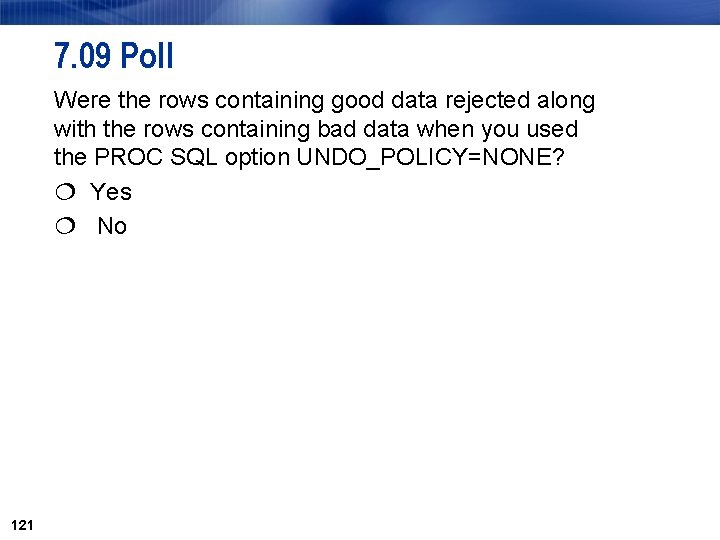
7. 09 Poll Were the rows containing good data rejected along with the rows containing bad data when you used the PROC SQL option UNDO_POLICY=NONE? Yes No 121
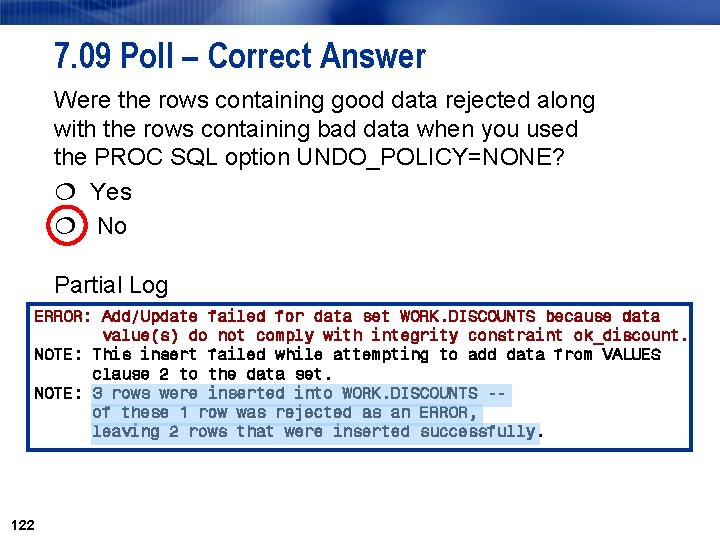
7. 09 Poll – Correct Answer Were the rows containing good data rejected along with the rows containing bad data when you used the PROC SQL option UNDO_POLICY=NONE? Yes No Partial Log ERROR: Add/Update failed for data set WORK. DISCOUNTS because data value(s) do not comply with integrity constraint ok_discount. NOTE: This insert failed while attempting to add data from VALUES clause 2 to the data set. NOTE: 3 rows were inserted into WORK. DISCOUNTS -of these 1 row was rejected as an ERROR, leaving 2 rows that were inserted successfully. 122
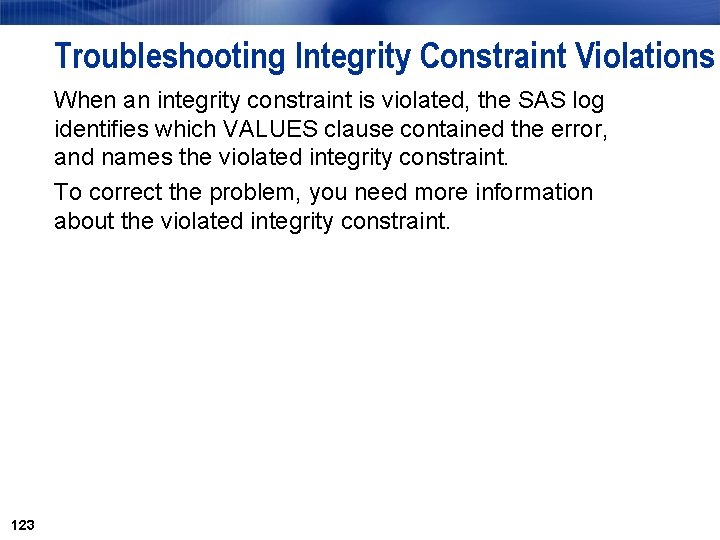
Troubleshooting Integrity Constraint Violations When an integrity constraint is violated, the SAS log identifies which VALUES clause contained the error, and names the violated integrity constraint. To correct the problem, you need more information about the violated integrity constraint. 123
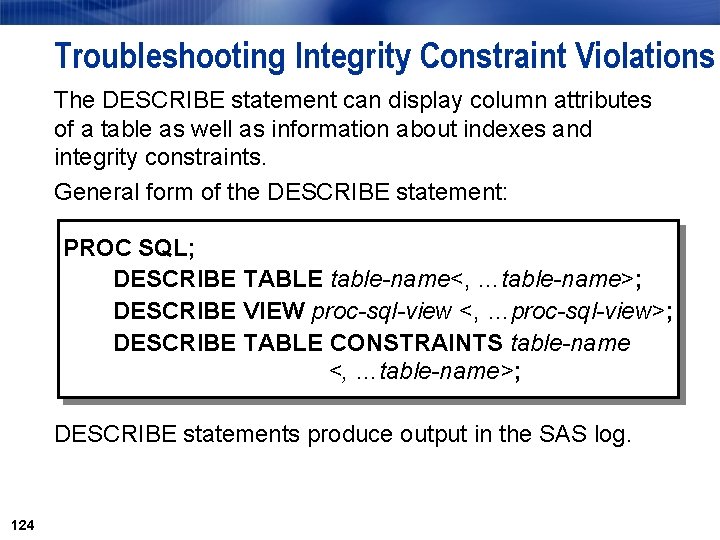
Troubleshooting Integrity Constraint Violations The DESCRIBE statement can display column attributes of a table as well as information about indexes and integrity constraints. General form of the DESCRIBE statement: PROC SQL; DESCRIBE TABLE table-name<, …table-name>; DESCRIBE VIEW proc-sql-view <, …proc-sql-view>; DESCRIBE TABLE CONSTRAINTS table-name <, …table-name>; DESCRIBE statements produce output in the SAS log. 124
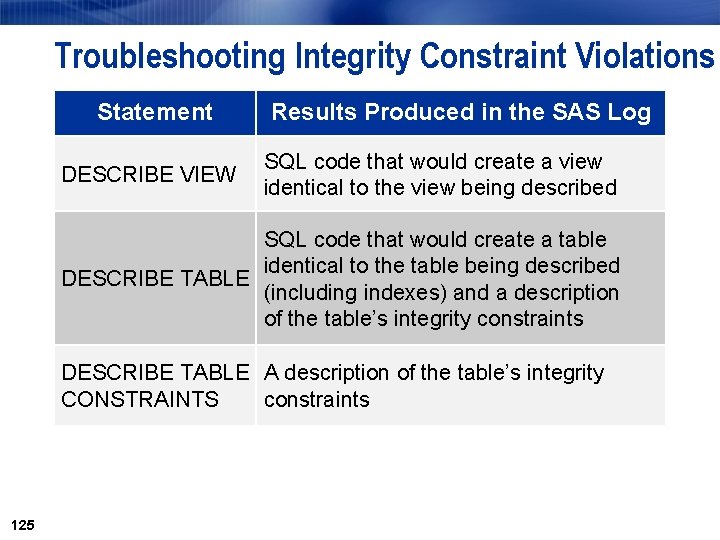
Troubleshooting Integrity Constraint Violations Statement DESCRIBE VIEW Results Produced in the SAS Log SQL code that would create a view identical to the view being described SQL code that would create a table identical to the table being described DESCRIBE TABLE (including indexes) and a description of the table’s integrity constraints DESCRIBE TABLE A description of the table’s integrity CONSTRAINTS constraints 125
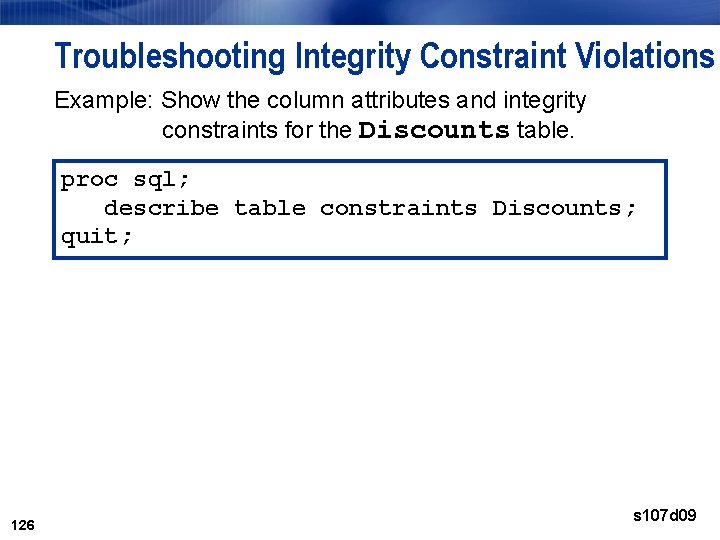
Troubleshooting Integrity Constraint Violations Example: Show the column attributes and integrity constraints for the Discounts table. proc sql; describe table constraints Discounts; quit; 126 s 107 d 09
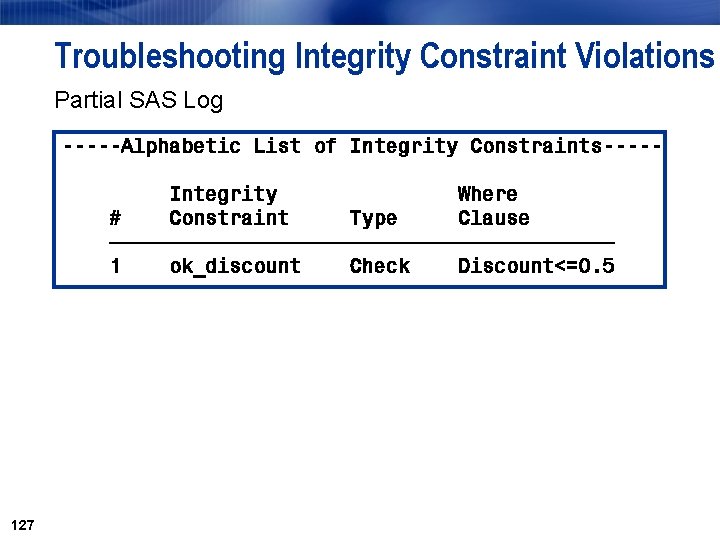
Troubleshooting Integrity Constraint Violations Partial SAS Log -----Alphabetic List of Integrity Constraints----Integrity Where # Constraint Type Clause ƒƒƒƒƒƒƒƒƒƒƒƒƒƒƒƒƒƒƒƒƒ 1 ok_discount Check Discount<=0. 5 127

128
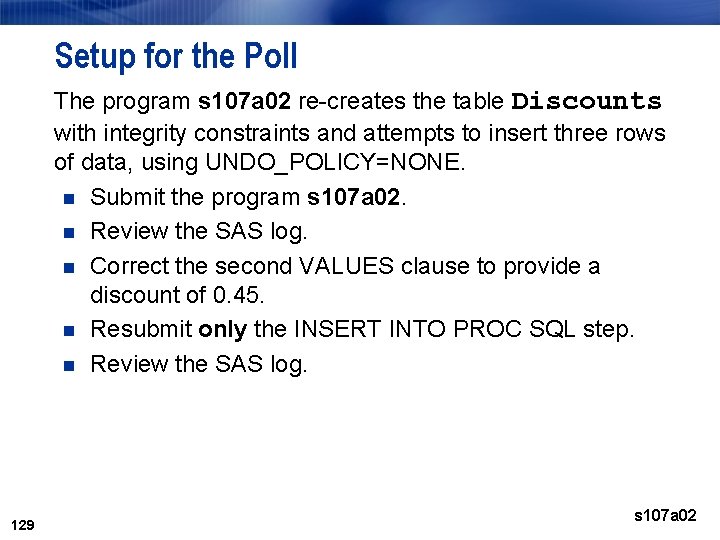
Setup for the Poll The program s 107 a 02 re-creates the table Discounts with integrity constraints and attempts to insert three rows of data, using UNDO_POLICY=NONE. n Submit the program s 107 a 02. n Review the SAS log. n Correct the second VALUES clause to provide a discount of 0. 45. n Resubmit only the INSERT INTO PROC SQL step. n Review the SAS log. 129 s 107 a 02

7. 10 Multiple Choice Poll After you correct and resubmit only the INSERT INTO query using UNDO_POLICY=NONE, how many rows are in the Discounts table? a. b. c. 130 5 3 2
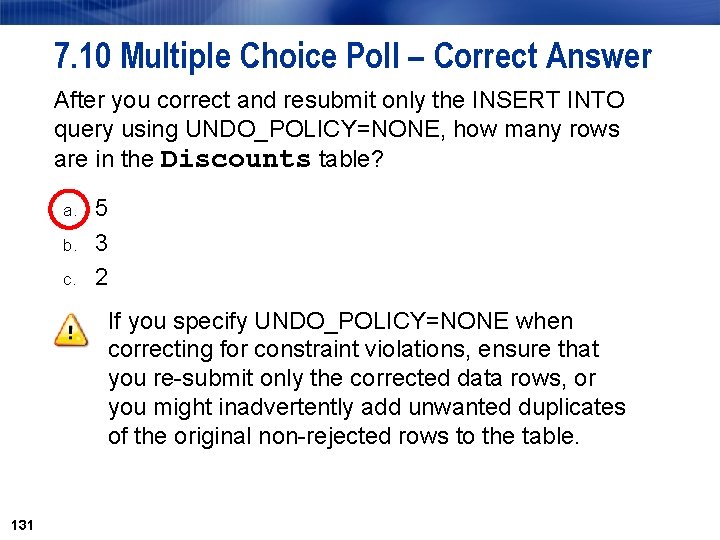
7. 10 Multiple Choice Poll – Correct Answer After you correct and resubmit only the INSERT INTO query using UNDO_POLICY=NONE, how many rows are in the Discounts table? a. b. c. 5 3 2 If you specify UNDO_POLICY=NONE when correcting for constraint violations, ensure that you re-submit only the corrected data rows, or you might inadvertently add unwanted duplicates of the original non-rejected rows to the table. 131
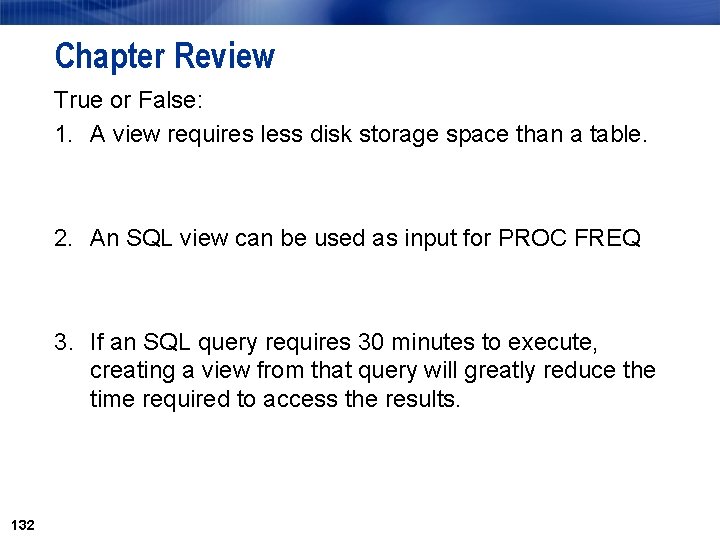
Chapter Review True or False: 1. A view requires less disk storage space than a table. 2. An SQL view can be used as input for PROC FREQ 3. If an SQL query requires 30 minutes to execute, creating a view from that query will greatly reduce the time required to access the results. 132
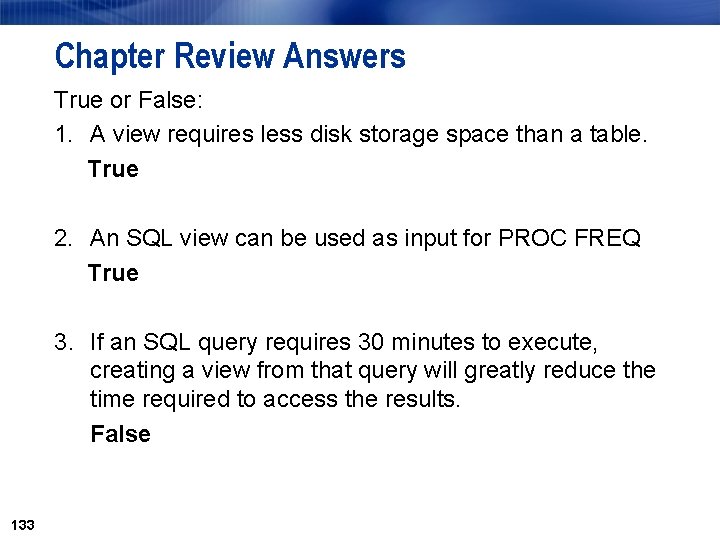
Chapter Review Answers True or False: 1. A view requires less disk storage space than a table. True 2. An SQL view can be used as input for PROC FREQ True 3. If an SQL query requires 30 minutes to execute, creating a view from that query will greatly reduce the time required to access the results. False 133
- Slides: 133